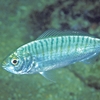General Description
Body long slender, head slightly flattened, tip of snout pointed; dorsal and anal fin short-based, far back on body, separated from tail fin; pelvic fins united to for a small sucking disc on the underside with a fleshy fringe on the hind margin. Greenish with a band of small black spots along sides and lower part of body, fins green with paler markings, an irregular white stripe along lower sides, a line of brown spots often along midline of back and a brownish line from side of snout, through eye to end of gill cover. To 3.2 cm.
Habitat
Inhabits seagrass beds and adjacent reefs, in depths of 0-10 m.
Reefs
Seagrass meadows
Distribution guide
South-eastern and south-western Australia. In western and central Victoria.
Species Group
Fishes › Clingfishes and shore-eels
Depth
Shore (0-1 m)
Shallow (1-30 m)
Water Column
Max Size
3 cm
Commercial Species
No
Global Dispersal
Native to Australia
Species Code
Genus nov C
Identify
Conservation Status
- DSE Advisory List : Not listed
- EPBC Act 1999 : Not listed
- IUCN Red List : Not listed





